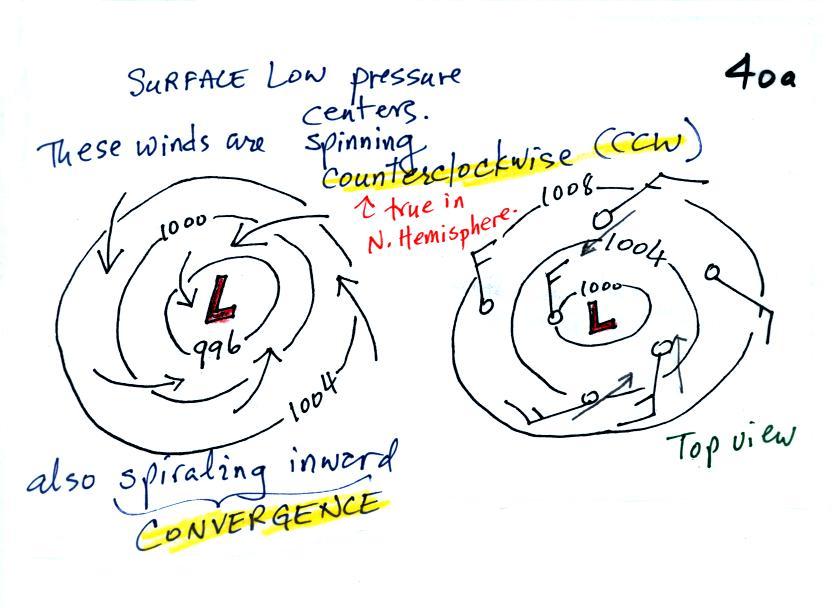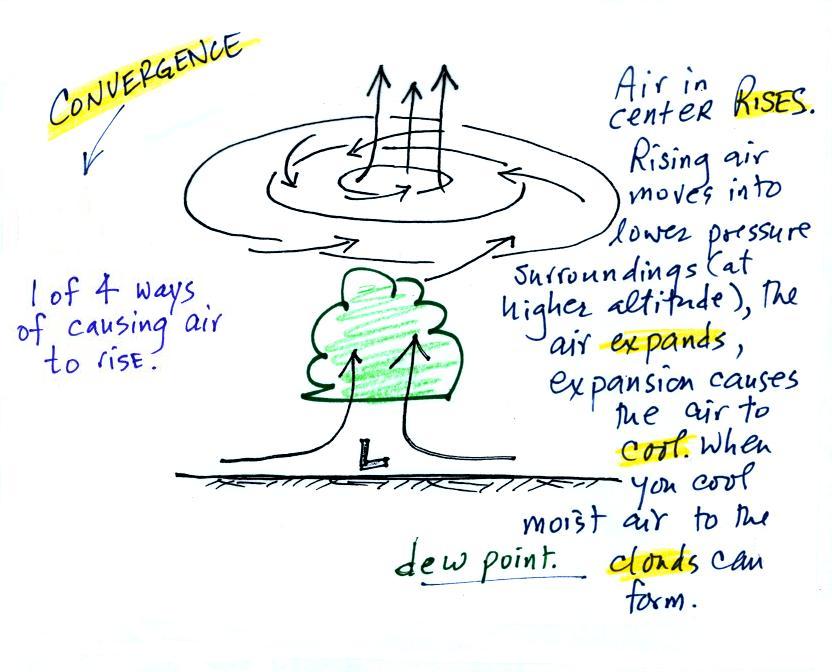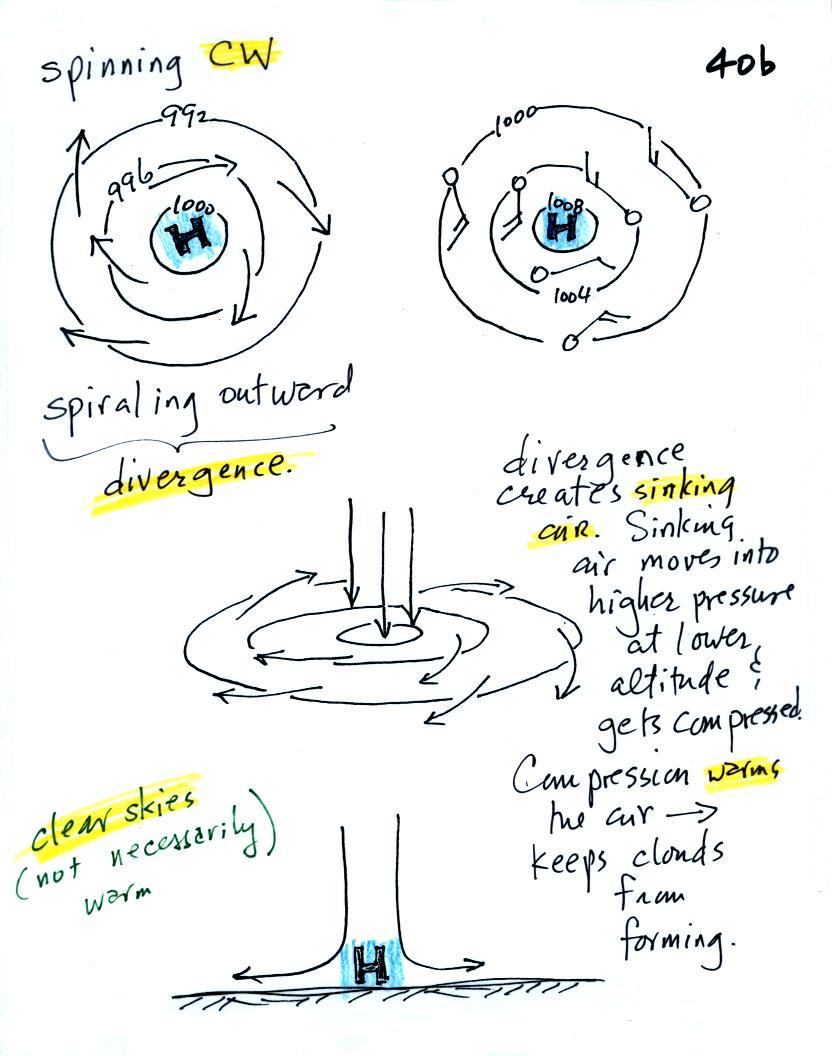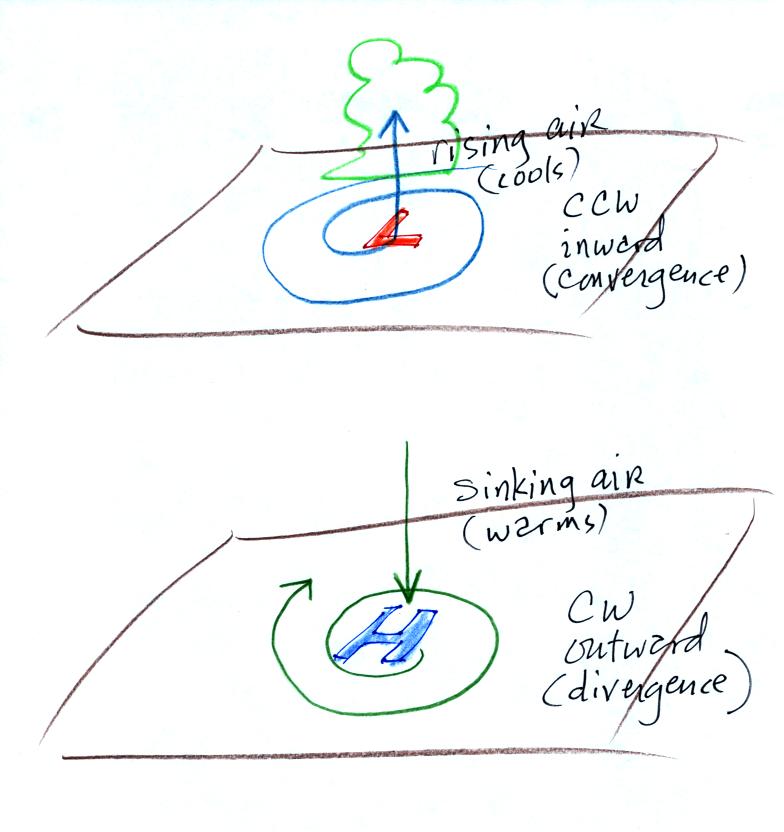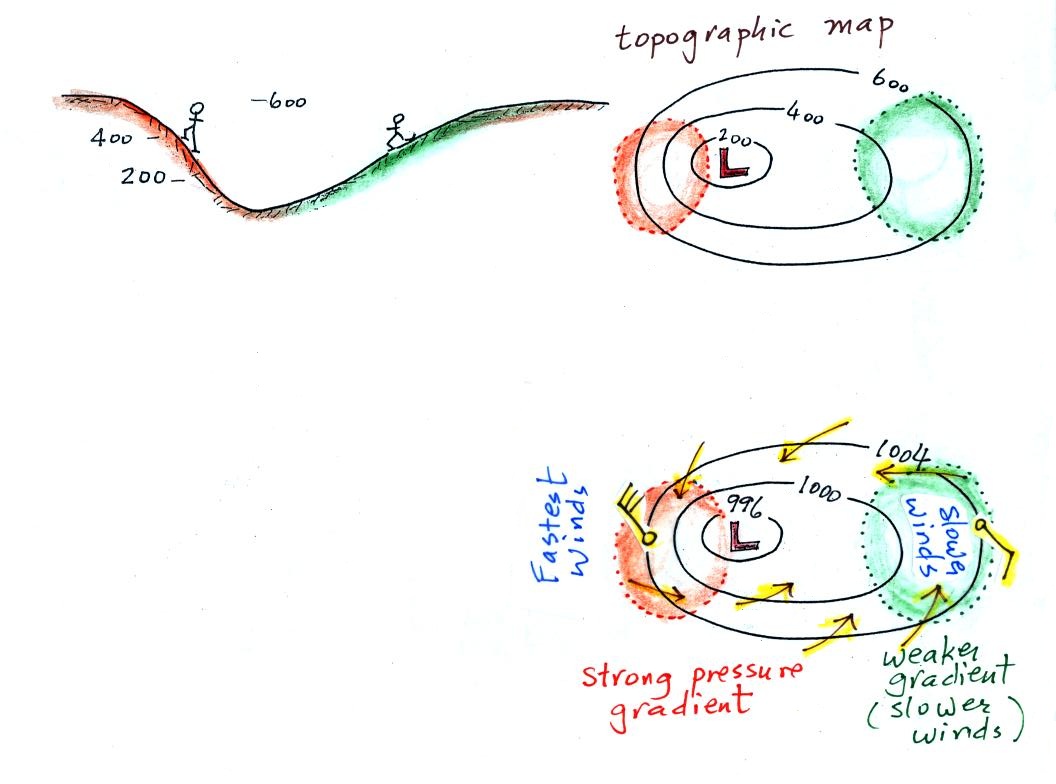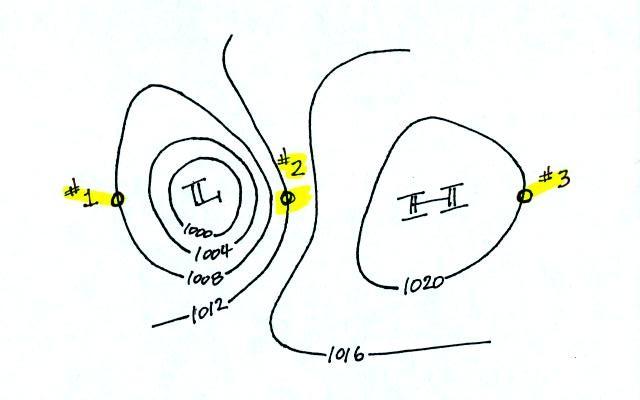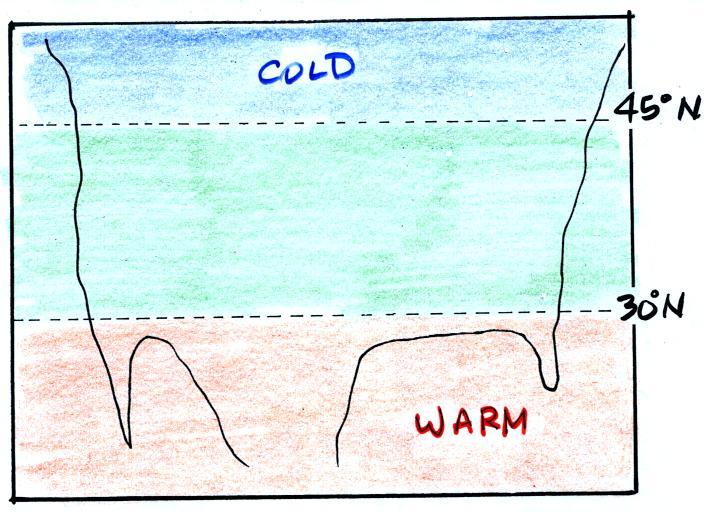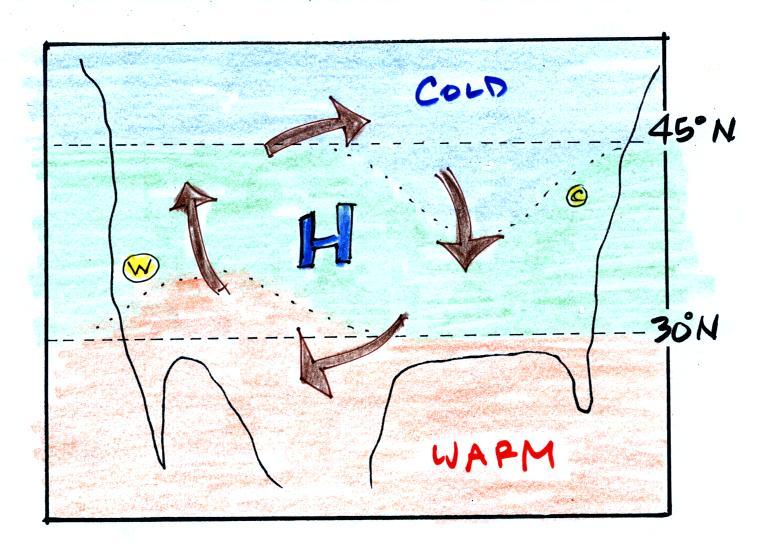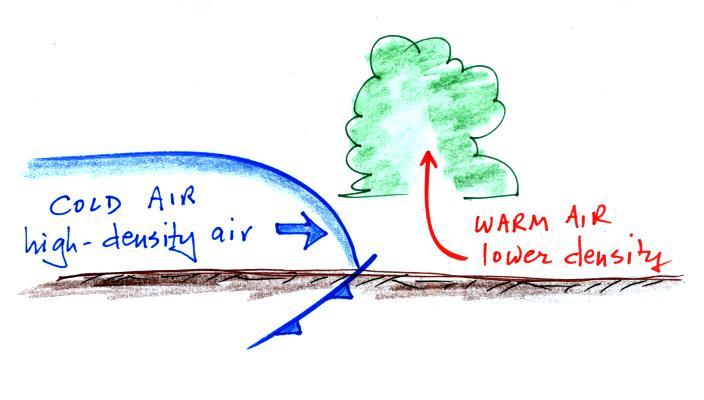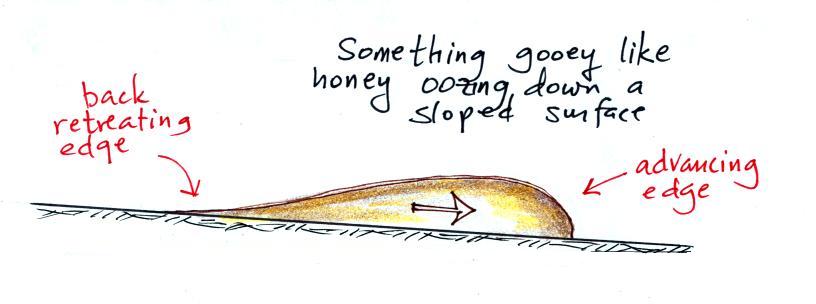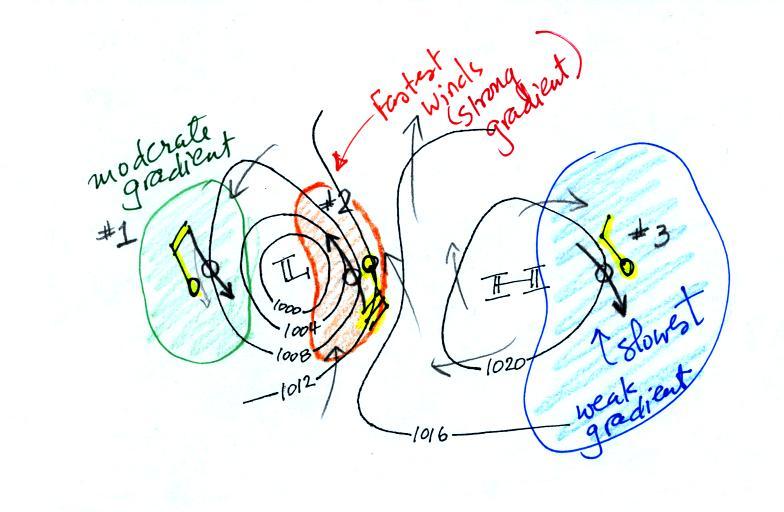Tuesday Oct. 1, 2013
Some "bluesy" music from Valerie June to accompany the US
Government shutdown. You heard "Raindance",
"Workin
Woman Blues", and "Pushin Against
A Stone"(3:16)
Quiz #1 has been graded and was returned in class today (I'll
have the quizzes with me on Thursday if you weren't able to pick
up your quiz today). The average score was 74%.
The calculation shows what you would end up with if you scored
74% on the remaining 3 quizzes and a 74% on the Final Exam.
You might think you would end up with a C, but that's not
necessarily the case.
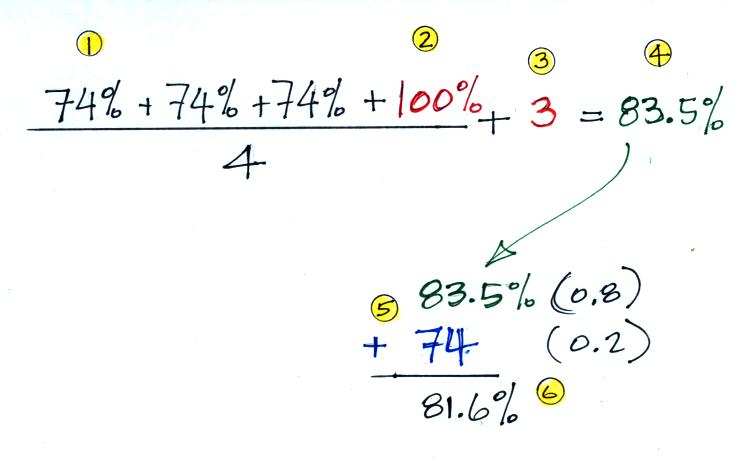
What I've done here is average together 3 quiz scores of 74%
(pt. 1) plus a writing grade of 100% (pt. 2). The 3%
that gets added on at Pt. 3 is extra credit. You earn extra
credit by turning Optional Assignments. Pt. 4 shows that you
would end up with an average of 83.5% on the last day of classes
before the Final Exam. If you score 74% on the Final Exam
(pt. 5) it would act to lower your average so it counts as 20% of
your overall grade. The 83.5% is the other 80%. You
overall average for the class would end up 81.6% (pt. 6), a B,
even though you got 74% on all the quizzes and exams. The
important point is that this would be possible only if you get a
really high writing score (by doing a good job on the experiment
report and by earning 45 1S1P pts) and do the extra credit
Optional Assignments.
Speaking of 1S1P pts, the 1S1P reports on Scattering of Light have
been graded and were returned in class. New 1S1P reports
topics should appear online soon. You can keep track of how
the grading is progressing on the reports you've turned here.
Here's the surface weather map we finished up with last week
before the quiz.
Today we're going to be seeing what the pressure pattern can begin
to tell us about the weather that is occurring on the map.
In particular, what is producing the cloudy rainy weather in the
NE part of the map and what is causing the rain shower along the
Gulf coast.
1.
We'll start with the large nearly circular centers of High and Low
pressure. Low pressure is drawn below. These figures
are more neatly drawn versions of what we did in class.
Air will start moving toward low
pressure (like a rock sitting on a hillside that starts to roll
downhill), then something called the Coriolis force will cause
the wind to start to spin (I didn't
mention the Coriolis force in class, we'll learn
more about it later in the semester).
In the northern hemisphere winds spin in a counterclockwise
(CCW) direction around surface low pressure centers. The
winds also spiral inward toward the center of the low, this is
called convergence. [winds spin clockwise around low
pressure centers in the southern hemisphere but still spiral
inward, don't worry about the southern hemisphere until later in
the semester]
When the converging air reaches the center of the low it starts to
rise. Rising air expands (because it is moving into lower
pressure surroundings at higher altitude), the expansion causes it
to cool. If the air is moist and it is cooled enough (to or
below the dew point temperature) clouds will form and may then
begin to rain or snow. Convergence
is 1 of 4 ways of causing air to rise (we'll learn what
the rest are soon, and, actually, you already know what one of
them is - warm air rises, that's called convection). You often see cloudy
skies and stormy weather associated with surface low pressure.
Everything is pretty much the exact opposite in the case of
surface high pressure.
Winds spin clockwise (counterclockwise in the southern
hemisphere) and spiral outward. The outward motion is called
divergence.
Air sinks in the center of surface high pressure to
replace the diverging air. The sinking air is compressed and
warms. This keeps clouds from forming so clear skies are
normally found with high pressure.
Clear skies doesn't necessarily mean warm weather, strong surface
high pressure often forms when the air is very cold.
Here's a picture summarizing what we've learned so far.
It's a slightly different view of wind motions around surface
highs and low that tries to combine all the key features in as
simple a sketch as possible.
2.
The pressure pattern will also tell you something about where
you might expect to find fast or slow winds. In this case
we look for regions where the isobars are either closely spaced
together or widely spaced. Portions of the two figures
that follow can be found on p. 40c in the ClassNotes.
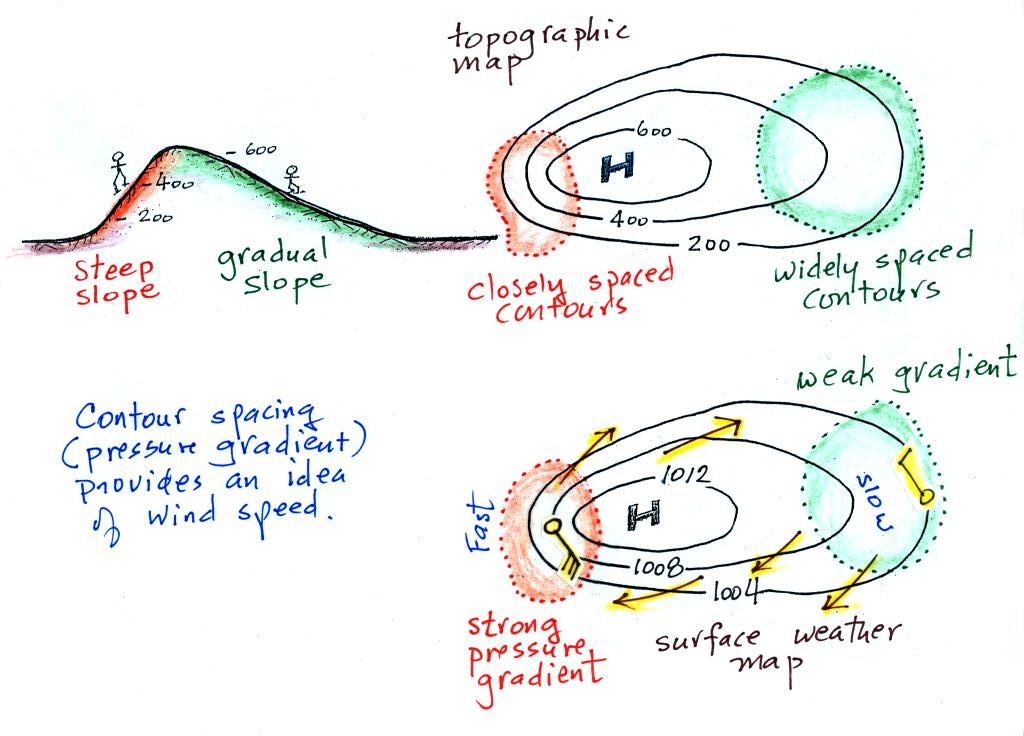
A picture of a hill is shown above at left. The maps at
upper right is a topographic map that depicts the hill (the
numbers on the contour lines are altitude). A center of
high pressure on a weather map, the figure at bottom left, could
have exactly the same appearance. The numbers on the
contours lines (isobars) would be pressure values in millibars.
Closely spaced contours on a topographic map indicate a steep
slope. More widely spaced contours mean the slope is more
gradual. If you stumble and fall while walking
on a hill, you will roll rapidly down a steep hillside, more
slowly down a gradual slope. You'd roll away from the
summit toward the outer edge of the topographic map.
On a weather map, closely spaced contours (isobars) means
pressure is changing rapidly with distance. This is known
as a strong pressure gradient and produces fast winds (a 30 knot
wind blowing from the SE is shown in the orange shaded region
above). Widely spaced isobars indicate a weaker pressure
gradient and the winds would be slower (the 10 knot wind blowing
from the NW in the figure).
The winds around a high pressure
center are shown above using both the station model notation and
arrows. The winds are spinning clockwise and spiraling outward
slightly (the outward motion away from high is analogous to the
hiker rolling downhill and away from the summit on a
hill). Note the different wind speeds (30 knots and 10
knots plotted using the station model notation). Fast
winds where to contours are close together and slower winds
where they are further apart.
Winds spin counterclockwise and
spiral inward around low pressure centers. The fastest
winds are again found where the pressure gradient is strongest.
This figure is found at the bottom of p. 40 c in the
photocopied ClassNotes. You should be able to sketch in the
direction of the wind at each of the three points and determine
where the fastest and slowest winds would be found. (you'll find
the answer at the end of today's notes).
3.
The pressure pattern causes the wind to start to blow; the wind
then can affect and change the temperature pattern. The
figure below shows the temperature pattern you would expect to see
if the wind wasn't blowing at all or if the wind was just blowing
straight from west to east. The bands of different
temperature are aligned parallel to the lines of latitude.
Temperature changes from south to north but not from west to
east.
This picture gets a little more interesting if you put
centers of high or low pressure in the middle.
In the case of high pressure,
the clockwise spinning winds move warm air to the north on the
western side of the High. The front edge of this northward
moving air is shown with a dotted line (at Pt. W) in the picture
above. Cold air moves toward the south on the eastern side
of the High (another dotted line at Pt. C). The diverging
winds also move the warm and cold air away from the center of
the High. Now you would experience a change in temperature
if you traveled from west to east across the center of the
picture.
The transition from warm to cold along the boundaries (Pts. W
and C) is spread out over a fairly long distance and is
gradual. This is because the winds around high pressure
diverge and blow outward away from the center of high
pressure. There is also some mixing of the different
temperature air along the boundaries.
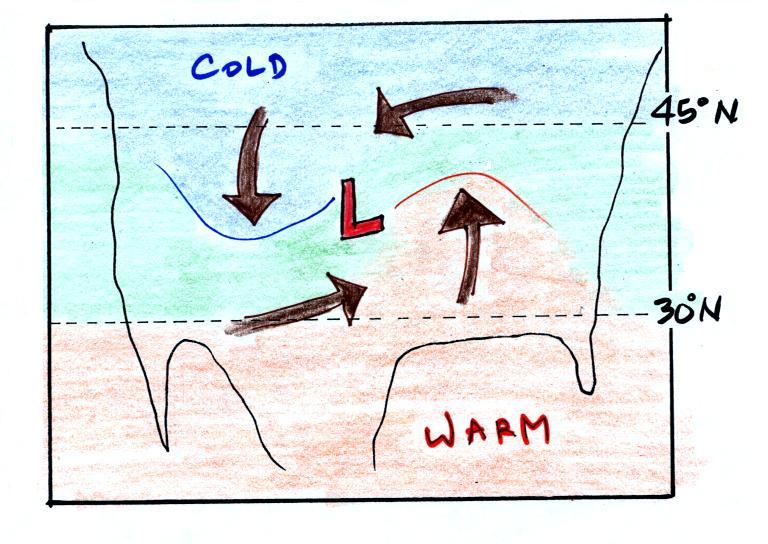
The converging winds in the case of low pressure will move the
air masses of different temperature in toward the center of low
pressure. The transition zone between different temperature
air gets squeezed and compressed. The change from warm to
cold occurs in a shorter distance and is sharper and more
distinct. Solid lines have been used to delineate the
boundaries above. These sharper and more abrupt boundaries are
called fronts.
A cold front is drawn at the front edge of the southward moving
mass of cold air on the west side of the Low. Cold fronts
are generally drawn in blue on a surface weather map. The
small triangular symbols on the side of the front identify it as a
cold front and show what direction it is moving.
A warm front (drawn in red with half circle symbols) is shown
on the right hand side of the map at front edge of the northward
moving mass of. A warm front is usually drawn in red and has
half circles on one side of the front to identify it and show its
direction of motion.
The fronts are like spokes on a wheel. The "spokes" will
spin counterclockwise around the low pressure center (the axle).
Both types of fronts cause rising air motions. Fronts are
another way of causing air to rise. Rising air expands and
cools. If the air is moist and cools enough, clouds can
form.
The storm system shown in the picture above (the Low together with
the fronts) is referred to a middle latitude storm or an
extra-tropical cyclone. Extra-tropical means outside the
tropics, cyclone means winds spinning around low pressure
(tornadoes are sometimes called cyclones, so are
hurricanes). These storms form at middle latitudes because
that is where air masses coming from the polar regions to the
north and the more tropical regions to the south can collide.
Large storms that form in the tropics (where this mostly just warm
air) are called tropical cyclones or, in our part of the world,
hurricanes.
We'll be looking in more detail
at the structure of warm and cold fronts and the weather
changes that can occur as they approach and pass
through. We'll also look at how you might go about
locating fronts on a surface weather map.
A vertical slice through a cold front is shown below at
left. Pay particular attention to the shape of the
advancing edge of the cold air mass. Friction with
the ground causes the front edge to "bunch up" and gives
it the blunt shape it has. You'd see something
similar if you were to pour something thick and gooey on
an inclined surface and watch it roll downhill.
The cold dense air mass
behind a cold front moves into a region occupied by warm
air. The warm air has lower density and will be
displaced by the cold air mass. In some ways its
analogous to a big heavy Cadillac plowing into a bunch of
Volkswagens.
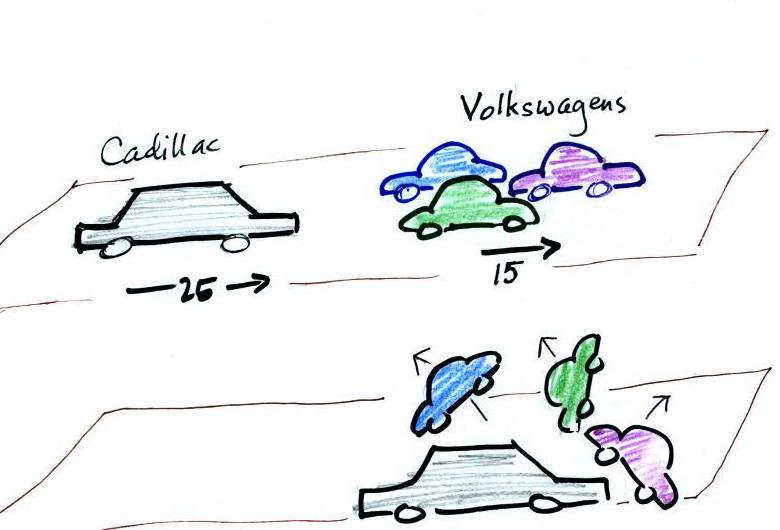
I showed several videos at this
point. The first was something I produced myself sort of
a laboratory version of a cold front. Because it is on
magnetic tape I can't put it online. The next
video was a time lapse movie of a cold front that came through
Tucson on on Easter Sunday morning, April 4, 1999. Click
here
to see the cold front video (it may take a minute or two to
transfer the data from the server computer in the Atmospheric
Sciences Dept., be patient). Remember this is a time
lapse movie of the frontal passage. The front
seems to race through Tucson in the video, it wasn't moving as
fast as the video might lead you to believe. Cold fronts
typically move 15 to 25 MPH.
The 2nd
video was another cold front passage that occurred on
February 12, 2012.
We were pretty much out of time at this point.
There's lots to still cover and we'll try to get all of that
done on Thursday.
Here is the map shown earlier. You were supposed to
draw in winds directions and determine where the fastest and
slowest winds would be.
Now that you know how winds can affect the
temperature pattern you should be able to determine which of
the 3 points would be warm and which would be cold.
Point 2 would be the warmest because winds there are coming
from the south. Winds at Points 1 & 3 are coming
from the north, that is likely to be cooler air.



